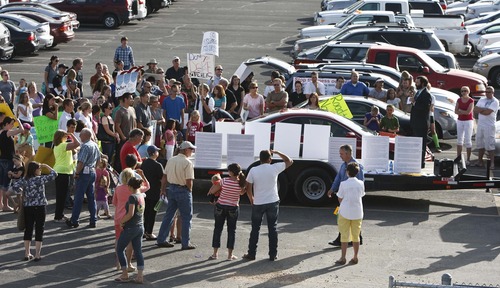This is an archived article that was published on sltrib.com in 2014, and information in the article may be outdated. It is provided only for personal research purposes and may not be reprinted.
The Utah Department of Transportation is again pushing back its schedule for deciding whether to build the proposed West Davis Corridor freeway, a project some federal agencies worry could destroy too many Great Salt Lake wetlands.
UDOT said Monday that the new delay is to allow time for more evaluation and discussion with groups pushing alternatives, including a "shared solution" that would entirely do away with the freeway by improving existing roads and adding more mass transit.
UDOT originally hoped to issue a final environmental impact statement — essentially its final decision on the project — by the end of 2013. It pushed that back to this summer. On Monday, the agency pushed it back again, this time to next spring, with a final federal record of decision penciled in for the summer of 2015.
But it could take longer.
"That depends on the outcome of the evaluation of the alternatives," said Randy Jefferies, UDOT project manager. "We've never let the schedule be the highest priority on this project. We want to make sure the process drives the schedule. Quality of the study is always the most important."
The freeway would be the northwest extension of the Legacy Parkway — which itself was built after a four-year legal battle over damage it could do to wetlands.
Compromise on Legacy resulted in a parkway that has a reduced speed limit, special sound-muffling pavement, a ban on trucks and extensive areas of preserved wetlands, open space and trails. The West Davis proposal did not include such mitigation.
When UDOT last year released a draft environmental impact statement on the planned freeway through western Davis and Weber counties, it received more than 1,600 formal comments.
Most concerning was one from the U.S. Army Corps of Engineers that threatened to deny permits needed for construction because of possible damage to wetlands.
The corps wrote that federal law allows it to permit only the least-damaging alternative route that is practical. It said UDOT's preferred route — which would begin at Glovers Lane in Farmington — "has the most acres of direct and indirect" impact of all finalist alternatives studied.
An alternative beginning farther north at Shepard Lane would be less damaging, the corps said.
But UDOT has said that route would destroy more homes and businesses. Other federal agencies, environmental groups and neighbors of Glovers Lane also oppose the Glovers Lane option.
Several groups have also pushed what they call the "shared solution" to avoid the freeway by improving transit and local roads.
Roger Borgenicht, a member of the Shared Solution Coalition, said his group, UDOT and others "have had very productive meetings on concepts and methodologies." The delay builds confidence and hope that UDOT is seriously looking at alternatives, he said.
Steve Erickson, spokesman for the Utah Audubon Council, said, "We've been hopeful that UDOT would examine alternatives to this freeway, and at least they are giving alternative options a good look-over."
"We don't know what the final alternative" will be, Jefferies said. "We've been collaborating very well ... to come up with some new ideas and evaluate whether they have merit, and will meet our transportation needs."



